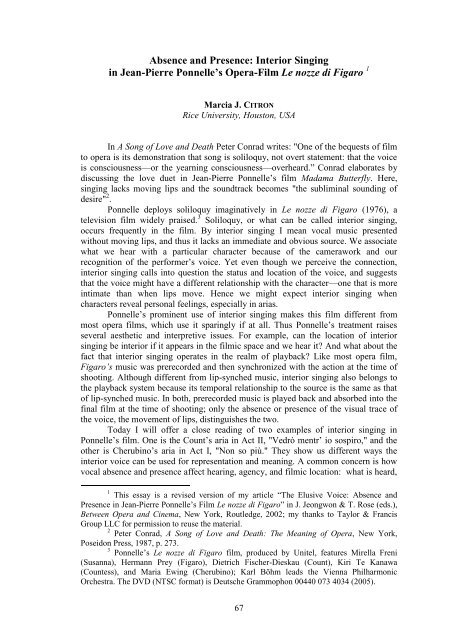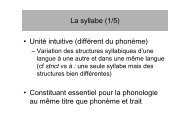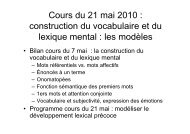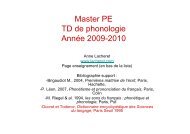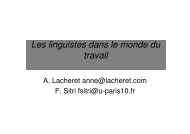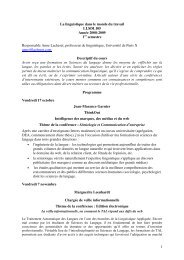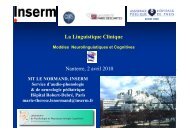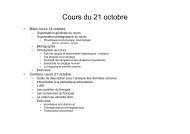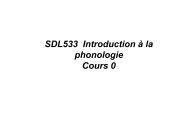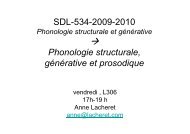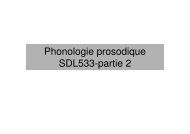Create successful ePaper yourself
Turn your PDF publications into a flip-book with our unique Google optimized e-Paper software.
Absence and Presence: Interior Singing<br />
in Jean-Pierre Ponnelle’s Opera-Film Le nozze di Figaro 1<br />
Marcia J. CITRON<br />
Rice University, Houston, USA<br />
In A Song of Love and Death Peter Conrad writes: "One of the bequests of film<br />
to opera is its demonstration that song is soliloquy, not overt statement: that the voice<br />
is consciousness—or the yearning consciousness—overheard.” Conrad elaborates by<br />
discussing the love duet in Jean-Pierre Ponnelle’s film Madama Butterfly. Here,<br />
singing lacks moving lips and the soundtrack becomes "the subliminal sounding of<br />
desire" 2 .<br />
Ponnelle deploys soliloquy imaginatively in Le nozze di Figaro (1976), a<br />
television film widely praised. 3 Soliloquy, or what can be called interior singing,<br />
occurs frequently in the film. By interior singing I mean vocal music presented<br />
without moving lips, and thus it lacks an immediate and obvious source. We associate<br />
what we hear with a particular character because of the camerawork and our<br />
recognition of the performer’s voice. Yet even though we perceive the connection,<br />
interior singing calls into question the status and location of the voice, and suggests<br />
that the voice might have a different relationship with the character—one that is more<br />
intimate than when lips move. Hence we might expect interior singing when<br />
characters reveal personal feelings, especially in arias.<br />
Ponnelle’s prominent use of interior singing makes this film different from<br />
most opera films, which use it sparingly if at all. Thus Ponnelle’s treatment raises<br />
several aesthetic and interpretive issues. For example, can the location of interior<br />
singing be interior if it appears in the filmic space and we hear it? And what about the<br />
fact that interior singing operates in the realm of playback? Like most opera film,<br />
Figaro’s music was prerecorded and then synchronized with the action at the time of<br />
shooting. Although different from lip-synched music, interior singing also belongs to<br />
the playback system because its temporal relationship to the source is the same as that<br />
of lip-synched music. In both, prerecorded music is played back and absorbed into the<br />
final film at the time of shooting; only the absence or presence of the visual trace of<br />
the voice, the movement of lips, distinguishes the two.<br />
Today I will offer a close reading of two examples of interior singing in<br />
Ponnelle’s film. One is the Count’s aria in Act II, "Vedrò mentr’ io sospiro," and the<br />
other is Cherubino’s aria in Act I, "Non so più." They show us different ways the<br />
interior voice can be used for representation and meaning. A common concern is how<br />
vocal absence and presence affect hearing, agency, and filmic location: what is heard,<br />
1 This essay is a revised version of my article “The Elusive Voice: Absence and<br />
Presence in Jean-Pierre Ponnelle’s Film Le nozze di Figaro” in J. Jeongwon & T. Rose (eds.),<br />
Between Opera and Cinema, New York, Routledge, 2002; my thanks to Taylor & Francis<br />
Group LLC for permission to reuse the material.<br />
2 Peter Conrad, A Song of Love and Death: The Meaning of Opera, New York,<br />
Poseidon Press, 1987, p. 273.<br />
3 Ponnelle’s Le nozze di Figaro film, produced by Unitel, features Mirella Freni<br />
(Susanna), Hermann Prey (Figaro), Dietrich Fischer-Dieskau (Count), Kiri Te Kanawa<br />
(Countess), and Maria Ewing (Cherubino); Karl Böhm leads the Vienna Philharmonic<br />
Orchestra. The DVD (NTSC format) is Deutsche Grammophon 00440 073 4034 (2005).<br />
67


